

|
Click here to return to Website Home page |
My interest in buses was kindled at a very early age
when in 1956, My family moved to a new house on the West End estate on the
outskirts of Fareham in Hampshire. This was near the Fairfield Avenue terminus
of Provincial's routes 1 and 3 to Gosport ferry. Over the years the terminus
moved further into the estate as building work progressed, and for a number of
years was almost outside our house.
Who could not be an enthusiast living in close proximity to the workings of this particular operator. I used to cycle the hundred or so yards down St Michael's Grove to the terminus and note the numbers of all the buses operating on these routes each day. There were usually 12 which ran the service each week day, and only when the first recorded showed up again would I return home.
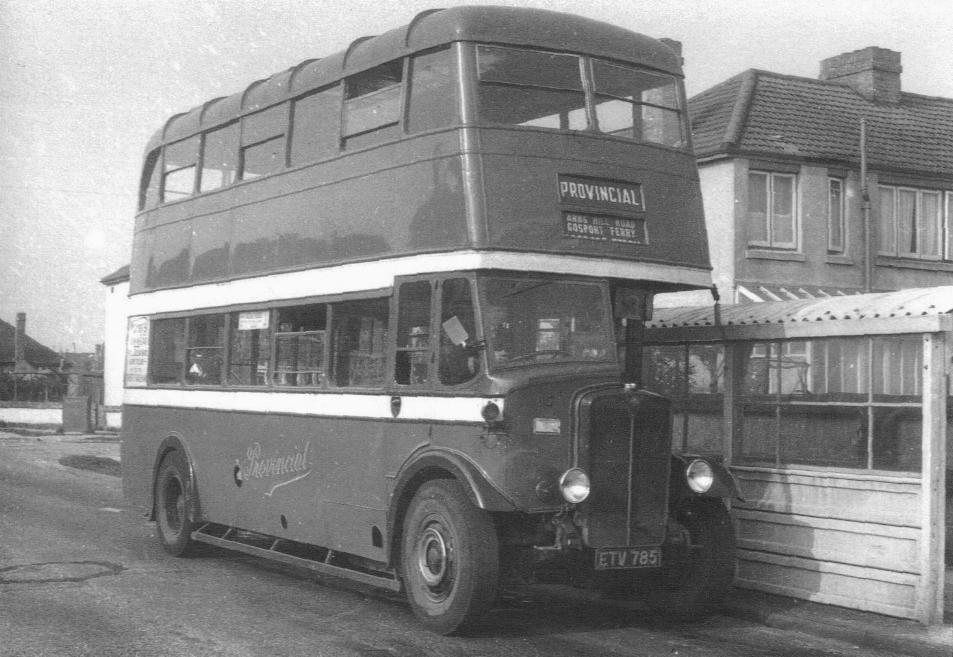
This is the place it all started. Ex Nottingham AEC Regent 65 (ETV 785) is seen
here at the Fareham (West End) terminus of routes 1/3 in St Michaels Grove,
adjacent to Fairfield Avenue. Photo: Fred York
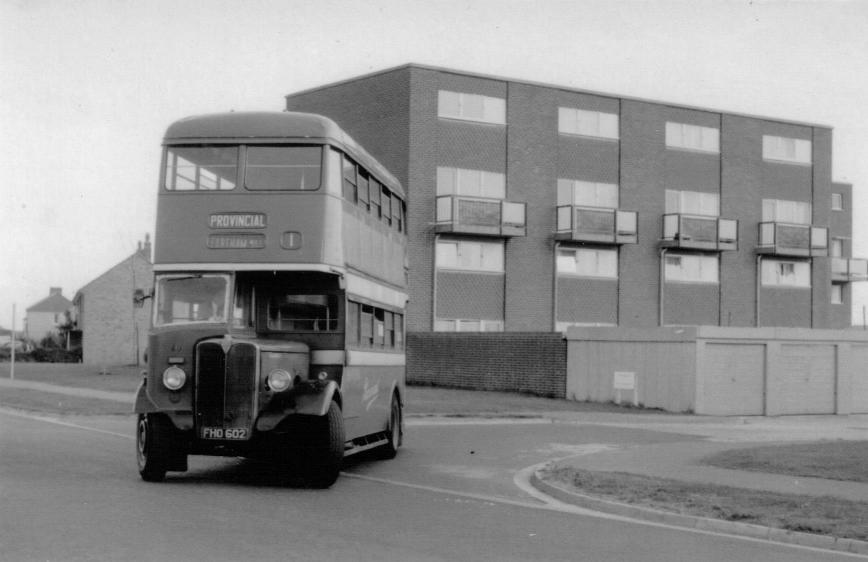
Later in the 1960s the terminus of routes 1 & 3 moved closer to my home in Longfield
Avenue. In August 1968, AEC Regent 10 (FHO
602) is seen reversing into the service road of Blenheim House before laying
over in the lay-by on the other side of the road before returning to Gosport
Ferry. The row of houses I lived in a the time can be seen in the
background. Photo: Fred York
The most common types seen at this time, were AEC Regents and Guy Arabs, and I had my favourites even then , which strangely enough were all second-hand vehicles. I think part of their attraction was the fact that they rarely seemed to appear on this route, and also that they were different to the native vehicles. The vehicles concerned were 48 - JML 784 , 72 - HHA 84 and 16- ACN 167. Number 48 was a 1938 AEC Regent demonstrator with Weymann body, which seemed to have a totally different engine noise to all other Provincial Regents. 72 was a 1945 ex Midland Red Guy Arab II (No 2589), with Northern Counties body work. This was later rebuilt with a fully fronted Reading body, and a Deutz air cooled engine in 1964.
Below 72 - HHA 84 in its original form is seen at the Gosport Ferry Terminus
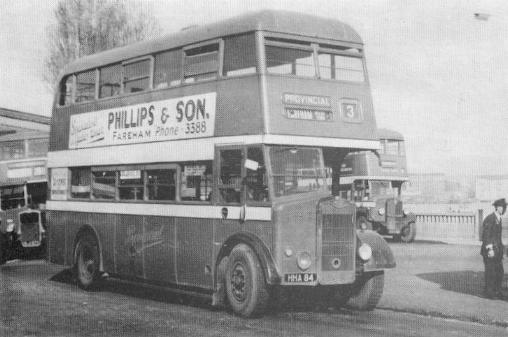
Below 72 - HHA 84 again after rebuilding with a Deutz air cooled engine also at Gosport Ferry
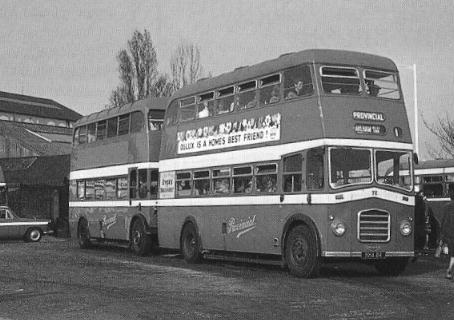
Fareham is situated roughly half way between Portsmouth and Southampton, and was a frontier town between two major companies, Southdown and Hants and Dorset. It was the farthest east H&D ran and the farthest west Southdown ran . This is not strictly true for Southdown's route 45 actually ran to Warsash a few miles west of Fareham, to which Hand D also ran a service (77). This situation meant that Fareham bus station always had a lot of interest for the PSV enthusiast. As well as the afore mentioned companies, long distance coach services also used it as a setting down and pick up point. A lot of these services originated from Portsmouth and Southsea and coaches from Black and White on the Cheltenham route and Royal Blue running to Bournemouth and Weymouth were the most common visitors. Bristol Greyhound coaches also put in an appearance. In the early sixties, most Royal Blue and Bristol Greyhound vehicles were Bristol MWs with REs also starting to appear. One oddity was that South Midland coaches on the Oxford - Southsea via Newbury route did not use the bus station., but used High Street as a setting down/picking up point instead. I used the service occasionally in the early to mid sixties as we had relatives in Oxford, and invariably travelled on a Bristol MW, usually one of the ORX, PRX registered batch of 1958/9.
The Hants and Dorset fleet was at this time almost totally Bristol, with Ks, Ls and ever increasing numbers of Lodekkas the order of the day. In the late fifties most of the single deck Bristol Ls were still rear entrance, but the move to OMO was gathering pace. I have fond memories of travelling on these over route 73A to Lee on Solent and Hill Head. The early sixties saw some of these vehicles sent back to ECW for lengthening and conversion to front entrance for OMO purposes. One thing that kept the bus spotters interest in Hants And Dorset's all Bristol fleet alive in those days was their use of colour coding fleet numbers for different garages. This meant that you could spot a rare interloper from , for instance Eastleigh, very quickly. this coding was carried on a small metal plate on the front and rear of vehicles. Fareham's colours were Green background with black numerals, Southampton's yellow background with black numerals and Winchester blue background with white numerals etc. In all their were nine different combinations. In NBC days the system was perpetuated for a while , but he plates were replaced by painting two different colour circles on the vehicles. One particular bus always springs to mind when I think of this time. It is 1334 - LRU 63 an ECW highbridge bodied KSW6G built in 1953. This particular vehicle always seemed to be running on route 73 to Heathfield Estate. No matter when I visited the bus station over a number of years it would be sitting there ready to depart on this route. I would imagine any enthusiast living on this route would be very frustrated by this lack of variety.
Southdown buses in Fareham were very much in the minority. two routes served the town 45 and 45A. The 45 service as mentioned earlier, started from Warsash ran thorough Fareham via the bus station , and then via the main road route through Portchester to Southsea , South Parade Pier. The 45A would start from the bus station and run via White Hart Lane Portchester, to Southsea, South Parade Pier. The vehicles used on these routes were at this time invariably The "Queen Mary" type of Leyland PD3/4, of the batch built in 1957-60, and usually the xxxx CD registered batch. Occasionally one of the older PD2s would be used , but I cannot remember travelling on one. I was always impressed by the "Queen Marys " as being a Provincial fan, Leyland buses were a novelty. they were also kept in a very clean condition and, in my opinion, the livery was one of the best ever used on a bus, Stagecoach take note!. Southdown did not use the Hants and Dorset garage in the bus station for keeping vehicles overnight, but had its own dormitory garage at Fareham Railway station. this was a small structure with room for about two buses only. Presumably it was to avoid having to return vehicles to Hilsea garage in Portsmouth at the end of the days service.
The Provincial bus stop which I used to return home after visiting Fareham was, at this time right outside the bus station in West Street, and it was waiting here one day in 1964, that I first saw number 14 - 270 MHO. This was at glance another Reading rebodied vehicle with a Deutz engine, but as it drew closer I could see that it was different. instead of having the now familiar diamond shaped plate on the front proclaiming "DEUTZ" , it had a much smaller rectangular plate, which read "Ruston air cooled diesel". The sound was also different, louder than the Deutz engined variety. This bus was unique , being the only fitted with a Ruston And Hornsby engine. On entering the bus there was something else that was different too, it was pink!. Provincial always had a high standard of internal decor, but it was usually green. No 14 had red seats, and everything else from seat backs to side panels was bright pink Formica. David Whitaker who was there at the time says "I was told that Readings had material over from one of the other companies for which they produced buses and it was economically convenient to use the material in 14 (it saved cash)" In any event the effect, surprisingly, was very pleasing (This "pink" treatment was also handed out to the second batch of ex Southampton Guy Arabs purchased in 1965) . This chassis for this unique bus came from various AEC Regents which had recently been dismantled by the company. It was eventually re-engined with a more conventional AEC engine and withdrawn in 1972.
Below 14 - 270 MHO is seen at Hoeford
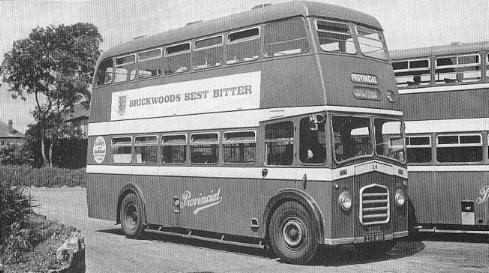
Bringing things more up to date, Provincial rose like a Phoenix from the NBC ashes and conquered the streets of Portsmouth before its identity disappeared under First Group ownership. However, it is kept alive by the Provincial Society! Hants and Dorset and Southdown are no more, Fareham bus station has been demolished and First Hampshire
& Dorset is now the legal owner of Provincial.
Title photo by Arthur Syson Click
here to return to Website Home page
![]()